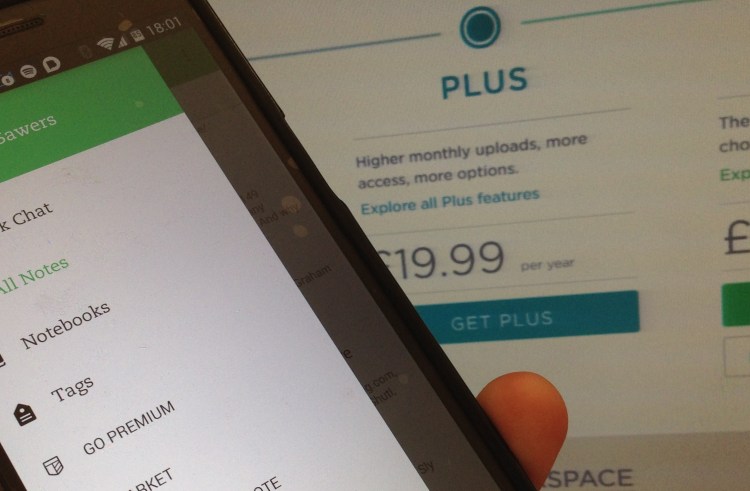Note-taking and archiving platform Evernote has introduced a new third tier to its freemium pricing model as it looks to solve the money-making conundrum and encourage users to pay.
From today, in addition to the Basic (free) and Premium tiers, Evernote is throwing a new Plus offering into the mix, serving as a bridge for those keen to upgrade but hesitant to fork out the full whack at first. The Premium tier remains at $5.99 per month or $49.99 per year in the U.S., but Plus comes in at half that — $2.99 per month or $24.99 per year.
On the free plan, you’re able to use most of the basic (hence the name) features, and it’s clear that Evernote is pitching this as a stepping stone to opening your wallet. From the announcement:
“This is where you’ll familiarize yourself with Evernote, install it on multiple devices, define your organizational style, and establish a workflow. You’ll learn, explore, and grow in this tier. Stay here as long as you like. When you’re ready, check out our more advanced levels.”
Evernote Plus, on the other hand, is aimed at the “engaged, active Evernote user.” The most obvious of the upgrades is access to 1GB of monthly note uploads at a maximum of 50MB per note, compared to 60MB and 25MB respectively on the basic plan. Other add-ons that may appeal to some include additional 2-factor verification options, full offline access on mobile (rather than temporary caches), and the ability to save 250 emails into Evernote, compared to zero on the free plan.
While the new Plus plan may steal the limelight in this particular news, Premium has been given a notable upgrade — unlimited uploads and a larger note-size limit of 200MB. A number of additional features may make this worth the extra investment too, including the ability to search for words within PDFs and Office documents, annotate PDFs, and scanning business cards.
You can see a full list of what you get on the various tiers here. It’s worth noting there is actually a fourth tier aimed at businesses called, well, Evernote Business. This includes a handful of super enterprise-focused features such as Salesforce integration.
Evernote’s move to offer a third, cheaper tier is indicative of the challenges faced by many so-called “freemium” companies. When the free offering works perfectly well for most people, then why would they pay for a bunch of extra features they may never use or need? Evernote’s announcement was actually quite frank in its explanation and rationality for the change.
“Premium models are tricky — to make them work, you need to strike the perfect balance between price, function, and audience. From the start, we focused ourselves on building Evernote over devoting time and energy to pricing theory.
We knew that premium offering wasn’t optimized for revenue, but there were always other things to think about. Over the past several months we’ve taken everything we’ve learned over the years and applied rigorous research to get our paid offering right. The process was eye-opening. As it turns out, there were three things users want: a basic level, a lower-priced tier, and a tier with unlimited uploads.”
By having a lower paid-tier, Evernote’s carrot-on-a-stick suddenly becomes more appealing to hitherto “free” users.


